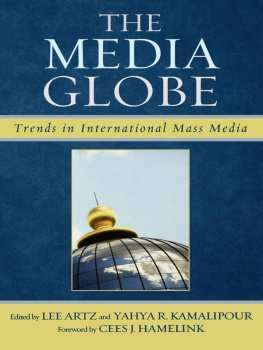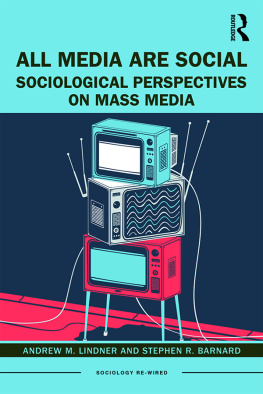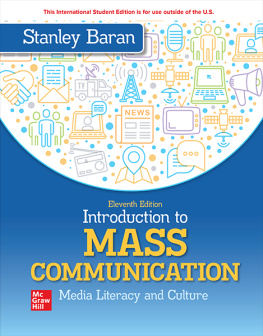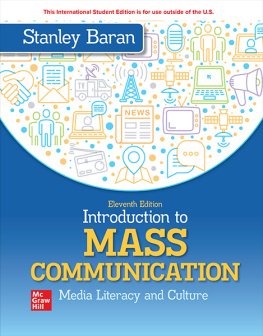Originally published in 1995 by Oxford University Press
Published 2000 by Transaction Publishers
Published 2017 by Routledge
2 Park Square, Milton Park, Abingdon, Oxon OX14 4RN
711 Third Avenue, New York, NY 10017, USA
Routledge is an imprint of the Taylor & Francis Group, an informa business
New material this edition Copyright 2000 by Taylor & Francis.
All rights reserved. No part of this book may be reprinted or reproduced or utilised in any form or by any electronic, mechanical, or other means, now known or hereafter invented, including photocopying and recording, or in any information storage or retrieval system, without permission in writing from the publishers.
Notice:
Product or corporate names may be trademarks or registered trademarks, and are used only for identification and explanation without intent to infringe.
Library of Congress Catalog Number: 00-023861
Library of Congress Cataloging-in-Publication Data
Bogart, Leo.
Commercial culture: the media system and the public interest / Leo Bogart.
p. cm.
Originally published: New York: Oxford University Press, 1995. With new introd.
Includes bibliographical references and index.
ISBN 0-7658-0605-3 (pbk. : alk. paper)
1. Mass mediaEconomic aspectsUnited States. 2. Mass media and cultureUnited States. 3. Mass media policyUnited States. I. Title.
P96.E252 U627 2000
302.23'0973dc21
00-023861
ISBN 13: 978-0-7658-0605-5 (pbk)
Publisher's Note
The publisher has gone to great lengths to ensure the quality of this book but points out that some imperfections from the original may be apparent.
The media system is even closer to the center of public attention than it was when this book first went to press five years ago. This preface reflects on what has happened, in that short time, in (1) the domain of technology, (2) the role of government, (3) media content, (4) integrity and (5) ownership, as well as in (6) the relationship of media to the political process.
Terms like "the information superhighway," only recently in vogue, now seem quaintly archaic. The technology that evolves at a bewildering pace has brought great changes, most of which continue the trends I trace in these pages. The Internet, a small cloud on the horizon of the mid 1990s, is already an important channel of massas well as personalcommunication as the new century gets under way.
The Impact of Technology
The World Wide Web
By 2000, half of American households had a personal computer, and about half of all adults had a Web connection at home or at work. A fifth claimed to get news from the Internet at least once a week, compared with 6% only two years earlier. However, there were some indications that the accelerating growth curve of P.C. usage might be tapering off. The dream of a P.C. in the hands of every child contrasted with the social realities that made computer-literacy a class-related aspect of ordinary literacy.
But the Web continued to expand its resources and to attract investment. Most established media had set up Web sites. Some major publications were betting that a good part of their readership would be switching from print to electronic delivery. Subscribers to on-line services could already get up-to-the minute news and financial data from Reuters, Bloomberg, The Wall Street Journal, The New York Times, and many other newspapers as well as from Web sites set up by cable networks. (The electronic version of the Wall Street Journal got a fifth of its income from its 375,000 subscribers.) Newspapers were putting their classified ads on-line automatically, to preempt competition rather than to capture new revenues.
Although newspaper and magazine publishers were all rushing to put out Web editions, few were making much money on the sale of advertising. Of the $233 billion American advertisers were spending annually, three billion dollars went into the new medium. About 120 dailies had abandoned their Web sites, at the same time that others were starting up.
There was money to be made from the sale of information on the Web. One woman, Jennifer Ringley, got several thousand voyeurs to pay $15 each to watch real-time pictures of her domestic life.
Digitization
Applications of the computer's binary code were transforming the production and delivery of media content. Digitization was changing the structure of the recording industry, with music transmitted on the Internet encouraging an upsurge of new genres. High fidelity DVDs were emerging as a replacement for videocassettes. In the film industry, digitization was lowering the cost of animation, and indeed of conventional movie production. Partly as a consequence, the number of pornographic movies annually produced in the United States tripled between 1993 and 1998. Digital time-compression devices were being used by radio stations to eliminate pauses between words and shorten syllables within words on talk shows, thereby scraping up time for as many as four additional minutes per hour of commercials.
Digital TV
The impact of digitization was most visible in the emerging convergence of the computer and the television set. The process found its most dramatic expression in some dramatic corporate mergers. The acquisition of Time-Warner by America On Line was hailed as the blending of "new media" and "old media." The $48 billion purchase by & of Tele-Communications Inc.(TCI), the nation's second-largest cable systems operator, made the telephone company a major factor in the news and entertainment business, even though TCI's associated program production interests (assembled in its affiliate, Liberty Media) remained under the control of chairman John Malone, who joined the & board. The prospect was opened for local as well as long distance telephone signals, Internet services and television programming to enter homes through a single line.
Even before this happened, a new generation of television sets equipped with enhanced software and a keypad could be hooked up to the Web either through cable or a telephone line. WebTV, a subsidiary of the all-encompassing Microsoft Corporation, was offering such a service to some 300,000 subscribers. In the meantime, a group of large cable system operators, ied by TCI, had contracted to buy millions of set-top boxes that would use the TV screen to display various computer services, including the Internet. TCI's Malone proposed using Sun Microsystem's Java software, bypassing Microsoft's Windows system.
High quality video imaging over the Internet had become a reality. The combination of telephone and cable wiring promised to overcome one obstacle to the prospect of using the Internet for TVthe limited capacity of copper telephone wires. Optic fibers could accommodate almost unlimited signal bandwidth, but their installation costs might reach $3,000 per household.
Converting the television set into a multimedia information utility depends on the transmission of digital signals like those used in computers. A television set using this technology would find many other uses: access to updated and customized news and data, music, video games, computer software, video cell-phone networks, pay-per-view movies on demand, paging services, and on-screen E-mail. A newspaper page might be downloaded in 1.25 seconds. And TV would become interactive, allowing viewers to manipulate the images they received and to feed back responses. (They could call up a baseball player's batting average or order advertised merchandise.)









